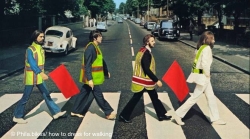
Did you know that 35,092 Americans died on roads last year. They were drivers, pedestrians and cyclists. They all had families. They didn’t think they would be dead. A population of 35,092 is similar to the population of Penticton, Powell River, or Prince Albert. It is a lot of people.
Tree Hugger author Lloyd Alter notes the contradiction of the unfortunate and strange policies in the City of Toronto, “where the mayor wants to reduce congestion and speed traffic up, while at the same time, reducing the carnage on the road that killed or injured a thousand people since June, and which can mainly be done by slowing traffic down”.
It’s absolutely clear that vehicles and their movement have precedence over vulnerable road users, those pedestrians and cyclists. “Especially troubling, this national data shows that the most vulnerable road users – people walking and biking, statistically more likely to be old or very young, poor, or of color – are, each year, an increasingly larger proportion of traffic fatalities. These fatalities, and the more than 2.4 million serious and life-altering injuries that happen annually on U.S. streets, are statistically predictable and preventable through better street design and reduced vehicle speeds”.
There is actually a paradox right now-while cars equipped with airbags and seat belts have been saving the lives of folks driving them, the environment for pedestrians and cyclists has really not improved in the same way. Vehicles are getting better, and are becoming mobile living rooms, with video players and distractions. It is suggested that this increased distraction coupled with busier roads is the reason that American pedestrian deaths were up 10 percent last year, the biggest increase ever.
We know that road speed can mean the difference between life and death for a vulnerable pedestrian or cyclist. NACTO (National Association of City Transportation Officials) “have proven that better street design, coupled with smarter, automated speed enforcement, is the best way to increase safety and save lives on U.S. roads. In Seattle, shortening pedestrian crossing distances on Nickerson Street reduced crashes by 23% and brought excessive speeding down from 38% to less than 2%”.
Redesigning our streets is absolutely key, because car drivers drive at the speed the road is designed for. Anyone driving Highway 17 out to Langley can attest that no one is driving the posted 80 kilometers per hour on that stretch. And there are many arterial roads in Metro Vancouver where drivers are speeding above the posted speed limit.
Sure we can lower speed limits, but we need to couple that with road design and enforcement. Sweden has led the way with the Vision Zero program. The Medical Health Officer of British Columbia’s Annual Report this year, Where the Rubber Meets the Road calling for lower speed limits and better road design to halt the 280 deaths and 79,000 injuries resulting from annual vehicle crashes. As Lloyd Alter notes, we can’t wait for driverless car technology to save us. We need to start this conversation now.


